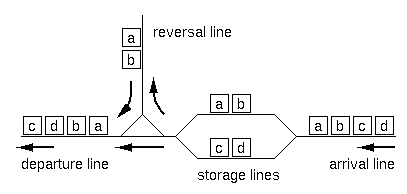POJ 3007
来源:互联网 发布:北外网络教育 编辑:程序博客网 时间:2024/06/05 06:56
题目大意,任意一位置将字符串分成两段A,B,每一段又将自己倒置形成一段新字符串,此时有字符串A(A+正序,A-逆序),B(B+正序,B-逆序)。有八种组合(A+B+),(B+A+),(A+B-),(B-A+),(A-B+),(B+A-),(A-B-),(B-A-); 问最多有多少种不重复的组合;
解法 枚举拆分+hush
Description
RJ Freight, a Japanese railroad company for freight operations has recently constructed exchange lines at Hazawa, Yokohama. The layout of the lines is shown in Figure 1.

Figure 1: Layout of the exchange lines
A freight train consists of 2 to 72 freight cars. There are 26 types of freight cars, which are denoted by 26 lowercase letters from "a" to "z". The cars of the same type are indistinguishable from each other, and each car's direction doesn't matter either. Thus, a string of lowercase letters of length 2 to 72 is sufficient to completely express the configuration of a train.
Upon arrival at the exchange lines, a train is divided into two sub-trains at an arbitrary position (prior to entering the storage lines). Each of the sub-trains may have its direction reversed (using the reversal line). Finally, the two sub-trains are connected in either order to form the final configuration. Note that the reversal operation is optional for each of the sub-trains.
For example, if the arrival configuration is "abcd", the train is split into two sub-trains of either 3:1, 2:2 or 1:3 cars. For each of the splitting, possible final configurations are as follows ("+" indicates final concatenation position):
[3:1] abc+d cba+d d+abc d+cba [2:2] ab+cd ab+dc ba+cd ba+dc cd+ab cd+ba dc+ab dc+ba [1:3] a+bcd a+dcb bcd+a dcb+a
Excluding duplicates, 12 distinct configurations are possible.
Given an arrival configuration, answer the number of distinct configurations which can be constructed using the exchange lines described above.
Input
The entire input looks like the following.
the number of datasets = m
1st dataset
2nd dataset
...
m-th dataset
Each dataset represents an arriving train, and is a string of 2 to 72 lowercase letters in an input line.
Output
For each dataset, output the number of possible train configurations in a line. No other characters should appear in the output.
Sample Input
4aaabbaabcdabcde
Sample Output
161218
Source
#include <iostream>#include <string.h>#include <stdio.h>#include <stdlib.h>#include <algorithm>#include <set>using namespace std;#define inf 40007char str[500][80];struct node{int g;struct node *next;};struct node *h[50000], *p, *q, *r;int top = 0;int ct = 0;void lianjie(char s1[], char s2[]){char ss[100];strcpy(ss, s1);strcat(ss, s2);int i, j;int ans = 0;int l = strlen(ss);for (i = 0; i < l; i++){ans += (ss[i] - 'a' + 1)*i ;}ans %= inf;if (h[ans] == NULL){strcpy(str[top], ss);p = new node;p->g = top;p->next = NULL;top++;h[ans] = p;ct++;}else{int flag = 0;q = h[ans];while (q){if (strcmp(str[q->g], ss) == 0){flag = 1;break;}q = q->next;}if (!flag){q = h[ans];while (q->next){q = q->next;}strcpy(str[top], ss);p = new node;p->g = top;p->next = NULL;top++;q->next = p;ct++;}}}void f(int l, int r, char s[]){int i, j;char s1[100], s2[100], s3[100], s4[100];for (i = 0; i < l; i++){s1[i] = s[i];s2[l - i - 1] = s[i];}s1[l] = s2[l] = '\0';for (i = l; i < r; i++){s3[i - l] = s[i];s4[r - i - 1] = s[i];}s3[r - l] = s4[r - l] = '\0';lianjie(s1, s3);lianjie(s3, s1);lianjie(s2, s3);lianjie(s3, s2);lianjie(s1, s4);lianjie(s4, s1);lianjie(s2, s4);lianjie(s4, s2);}void init(){ct = 0;for (int i = 0; i <= 49999; i++){h[i] = NULL;}top = 0;}int main(){int n, m, i, j;char s[100];scanf("%d", &n);while (n--){init();scanf("%s", s);int l = strlen(s);if (l == 1){printf("1\n");}else{for (i = 1; i < l; i++){f(i, l, s);}printf("%d\n", top);}}return 0;}- poj-3007
- POJ 3007
- poj 3007
- POJ 3007 hash表
- poj 3007 哈希
- POJ 3007(字符串hash)
- poj 3007 stl
- POJ
- poj
- POJ
- POJ
- poj
- poj
- POJ
- POJ
- poj
- POJ
- POJ
- Web前端大冒险 第二章 JSP函数大冒险(一)函数基础
- 傅立叶级数和傅立叶变换是什么关系?
- tar:time stamp in the future【偶尔发现的小问题】
- 关于The import android.support.v7.app cannot be resolved
- Spark生态之Alluxio学习11--alluxio-1.3.0集群配置
- POJ 3007
- linux ftp命令
- poj 1703 Find them, Catch them
- java.lang.IllegalStateException: Can't change tag of fragment xxxFragment
- 关于flask中Role的解释
- php 二位数组排序方式
- Linux下gcc宏定义作用域
- Spark生态之Alluxio学习12--spark调用alluxio-1.3.0配置
- hduoj 2084


